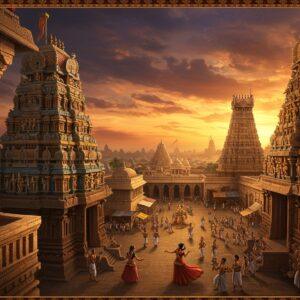
In India, temples are more than just places of worship; they are vibrant hubs of community life, echoing with centuries of cultural heritage. Each region showcases unique architectural styles, a testament to the diverse history, geography, and traditions woven into the fabric of our nation. Join us as we embark on a captivating exploration of Hindu temple architecture, traversing the diverse landscapes of India, from the southern tip to the northern plains and the western reaches.
South Indian Temples: Grandeur and Intricacy
South Indian temples are instantly recognizable by their majestic gopurams, the towering gateway towers adorned with elaborate carvings of deities, mythological scenes, and intricate floral patterns. The Dravidian style reigns supreme here, characterized by pyramid-shaped towers, known as vimanas, and a profusion of detailed sculptures. These architectural marvels are often crafted from granite, lending them a unique and enduring presence. The temple complexes are typically expansive, featuring multiple concentric enclosures, creating a sense of sacred space. Temple festivals are integral to South Indian culture, vibrant celebrations filled with dance, music, and colorful processions. Dynasties like the Cholas, Pandyas, and Vijayanagara have left an indelible mark on the region’s temple architecture and artistic style. These temples also serve as important centers for learning and preserving India’s rich tapestry of classical arts and traditions. A prime example of this architectural brilliance is the Brihadeeswarar Temple in Tamil Nadu, a UNESCO World Heritage Site renowned for its massive vimana and breathtaking Chola-era art. You can delve deeper into the intricacies of Dravidian architecture with our detailed guide here.
North Indian Temples: Elegance and Spirituality
North Indian temples, with their distinctive shikharas (spires) and intricate ornamentation, exude a different kind of charm. The Nagara style is prevalent in this region, distinguished by its curvilinear, beehive-shaped towers, primarily constructed using sandstone and marble. The Kashi Vishwanath Temple in Varanasi, with its gold-plated spire, stands as an iconic example of this style. Regional kingdoms and the Mughal period have also influenced North Indian temple architecture, resulting in a fascinating blend of indigenous and Islamic elements in certain areas. These temples hold immense spiritual significance and are central to Hindu pilgrimage, particularly during festivals like the Kumbh Mela. The sculptures adorning these temples often depict gods, goddesses, and celestial beings, adding layers of symbolic meaning to the structures. They serve as vital community hubs, hosting religious and social gatherings, and deeply influencing local culture. Explore the nuances of Nagara and Dravidian architecture through our comparative guide here and delve into the wider spectrum of Hindu architectural styles here. To appreciate how tradition blends with modern design in Hindu architecture, visit this link.
Western Indian Temples: Fusion and Artistry
Western India presents a captivating blend of architectural influences from various cultures and dynasties. The Māru-Gurjara (or Solanki) style stands out, known for its ornate carvings and elaborate toranas (gateway arches). The Sun Temple at Modhera, Gujarat, perfectly exemplifies this style and is renowned for its precise alignment with the equinoxes. Temple rituals in Western India are unique and elaborate, often involving aarti ceremonies and pujas dedicated to regional deities. The influence of maritime trade is evident in coastal temple architecture, where diverse cultural elements seamlessly merge. Jainism has also significantly influenced temple architecture in Gujarat and Rajasthan, leading to the creation of opulent Jain temples. Preservation of these historical structures is an ongoing challenge, given the impact of time and environmental factors, but these efforts are crucial for safeguarding India’s architectural heritage for generations to come. These temples serve as strong anchors of community identity, ensuring the continuity of traditional practices and keeping our rich cultural heritage alive.
Bringing the Temple Home with Poojn.in
Poojn.in empowers you to embrace these regional temple traditions within the comfort of your home. We offer a curated collection of authentic puja items sourced from across India, allowing you to create a sacred space that resonates with your regional heritage.
Elevate Your Puja with Authentic Items from Poojn.in
- Regional Temple Bells: Find traditional brass and copper bells, reminiscent of those used in temples throughout India. From the simple elegance of North Indian temple bells to the ornate designs of South Indian ones, we offer a diverse selection. You might like our pure brass Mangalchandi Santoshi Mata statue, perfect for your home altar.
- Specialized Puja Thalis: Our puja thalis cater to regional variations, reflecting the customs of major temples across India, including Varanasi-style, South Indian, and Bengali traditions. Consider our pure brass Lakshmi and Ganesha idol for prosperity and auspicious beginnings.
- Temple-Style Diyas: Illuminate your puja space with our selection of diyas, from simple clay diyas to ornate brass temple-style lamps, reflecting the diverse customs of different regions. Our exquisite Adiyogi marble dust murti would bring a touch of serenity to your home.
- Regional Incense and Dhoop: Immerse your senses in the traditional fragrances of temples across India with our range of incense and dhoop, including South Indian sambrani and North Indian loban.
Bring the sanctity of the temple into your home. Visit www.poojn.in or connect with us:
- Call: 03369029784
- WhatsApp: 9476142738
Our team of experts is ready to assist you in choosing the perfect items that align with your regional traditions. All our products are quality assured and packaged securely to preserve their sanctity. If you are a devotee of Lord Shiva, explore our collection of Lord Shiva murtis, including the standing Shiva murti and the Ganga Shiva murti.
Celebrating the Diversity of Hindu Temple Architecture
The architectural styles of Hindu temples across India beautifully showcase our nation’s rich cultural tapestry. Each region, with its own distinct designs and traditions, adds a unique and invaluable chapter to India’s architectural narrative. From the towering gopurams of the South to the elegant shikharas of the North, and the intricately carved temples of the West, every temple stands as a testament to devotion, history, and artistic mastery. These temples are not merely places of worship; they are living, breathing parts of our community, providing spaces for learning, celebration, and the preservation of time-honored traditions. By cherishing and preserving these magnificent structures, we honor the legacy of those who built them, ensuring that their stories continue to inspire generations to come. Through understanding and appreciating these regional variations, we deepen our connection to India’s rich cultural heritage. Let us continue to explore, respect, and celebrate the incredible diversity that makes India’s temple architecture truly exceptional.


